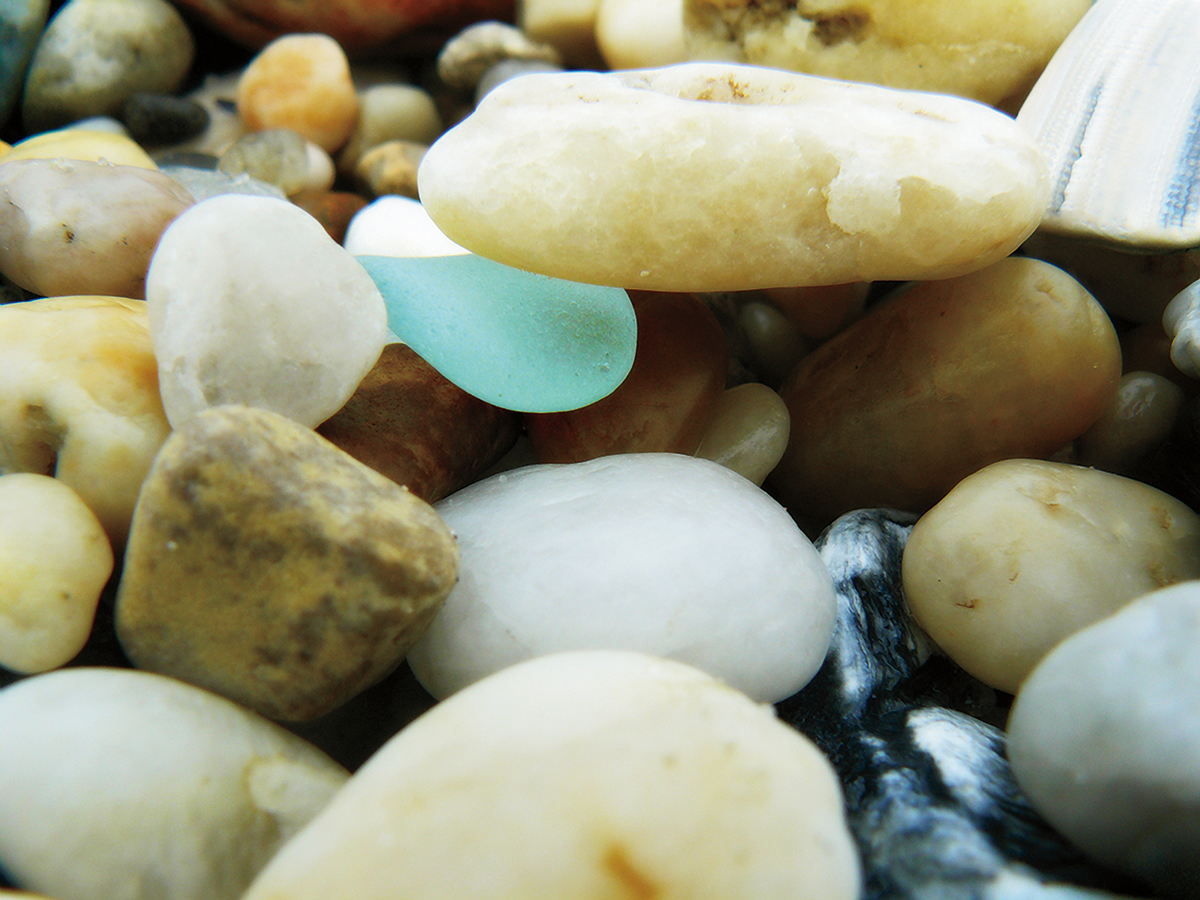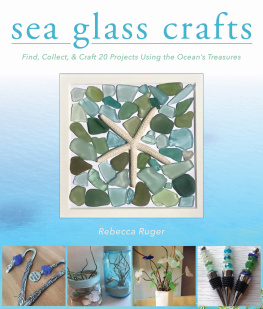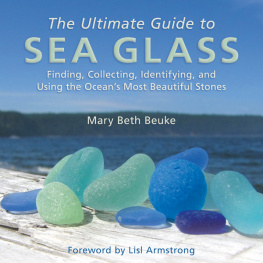I am walking along the edge of the tide, lost in my own watery, oceanic world. I am searching the sand for glistening pieces of sea glass. Sea glass, for those who dont know, starts out as glass bottles and jars and such that end up in the ocean due to littering, shipwrecks, and various other reasons. As this glass gets tossed around and broken apart by the waves, its jagged sharp edges get worn down over time so that the pieces are rounded and smooth and the surface develops a beautiful frosted coating. All this takes approximately 40 to 50 years to develop. Rough surf dislodges this glass from the oceans floor and brings it to the surface, where it travels the tide to settle upon whatever beach is nearby. Sea glass is relatively rare, so those lucky enough to find it often collect it and bring it home with them. Some people enjoy finding the gems so much they invest a lot of time and effort to locate them on the beaches.
Others tell me they would love to find sea glass during their vacations and yet they have never found any. During this lovely sunny day, while I am walking along the edge of the water, I am startled from my reverie by a gentleman who whisks past me, head down, moving very swiftly along the same section of tideline that Im studying. He occasionally stops to pick something up and I just know he is looking for sea glass too. He moves quickly down the beach, scanning the sand. I watch him as he bends down every now and then to investigate something. He has distracted me from my search, and I fight with myself to relax and enjoy my own experience and not worry about what he is doing; yet I wonder if he has found any gems. Nevertheless, I am pretty successful because without even being aware of it, I am getting closer to the end of the beach where the gentleman was earlier, only now he is gone. Its 15 or 20 minutes after low tidethe perfect time to look for sea glassand I am finding some beauties on the beach.
The best discovery comes when I spot a piece of orange sea glass lying in the sand about 3 feet back from the water! I am surprised that it is lying there because I know someone walked past here before I did. You see, orange sea glass is the rarest color to find. Some people have never been able to add this color to their collections, and I was one of them until now! I shake my head in disbelief at all the colors I found that the gentleman before me missed. Why did he miss them? Well, thats what this book is all about.
There are certain things you can do to avoid being that guy on the beach who misses all the great treasures. I will give you searching tips that can increase your likelihood of coming home with a gem. The gems that can be found on beaches are not limited to glasssometimes shards of pottery worn smooth by the sea wash up on the shore with the tide. I include these pieces of pottery when I refer to sea glass throughout this book.


I didnt spot this pottery piece in the pebbles the first time I walked through here.
You might think that all there is to finding sea glass is looking at the sand as you walk along a beach, but that is an oversimplification. These tips will help you spot even small shards you would otherwise miss.
 Retrace your steps. Imagine that youre walking along the shoreline, making your way down the beach, taking care to look at the beach thoroughly as you go along. Youre most likely thinking you have covered the area pretty welland you probably havebut then, turn around and walk back through the area youve just searched. Walking in the opposite direction might seem redundant, but it is valuable to change your visual perspective as it relates to the light and the lay of the land. What you see when the light is at your back will be different from what you see when you are facing into the light because of the shadows created by rocks, shells, driftwood, seaweed, and footprints on the beach. The shadows can conceal a shard of sea glass that you could spot when you change your direction.
Retrace your steps. Imagine that youre walking along the shoreline, making your way down the beach, taking care to look at the beach thoroughly as you go along. Youre most likely thinking you have covered the area pretty welland you probably havebut then, turn around and walk back through the area youve just searched. Walking in the opposite direction might seem redundant, but it is valuable to change your visual perspective as it relates to the light and the lay of the land. What you see when the light is at your back will be different from what you see when you are facing into the light because of the shadows created by rocks, shells, driftwood, seaweed, and footprints on the beach. The shadows can conceal a shard of sea glass that you could spot when you change your direction.
I always retrace my steps when Im searching, and no matter how many times it happens, I am always shocked when I spot a shard of glass that I missed the first time around. Whether it was the glare from the sun or shadows on the beach that caused me to miss it the first time, the most important thing is that I came home that day with my treasure!

Sea glass can be partially hidden, so move along slowly and be observant.

The triangular shape of this pottery shard stands out among the rounded stones.

 Dont search by looking for colors alone; look for shapes as well. Obviously, when you are beachcombing, you are looking for sea glass mostly by its color. Beautiful aqua and green colors are especially easy to see against the contrasting beige sand. But you will find more treasures by learning to train your eyes to search for shapes. Sea glass isnt always going to be a bright color that stands out. It could be a shade of white, brown, gray, or yellow that blends in with the shells, pebbles, and sand. When thats the case, the shape of the sea glass could catch your eye instead. For instance, when there are a lot of shells or pebbles (which are mostly a rounded shape) on the beach, a rectangular or triangular shard will stand out. This is how I made one of my best finds! It was a piece of white pottery that had a faint purple design on its surface, but the beach I was searching was primarily made up of small, perfectly round, white and beige pebbles. A square shape suddenly caught my eye; the square stood out against all the round stones.
Dont search by looking for colors alone; look for shapes as well. Obviously, when you are beachcombing, you are looking for sea glass mostly by its color. Beautiful aqua and green colors are especially easy to see against the contrasting beige sand. But you will find more treasures by learning to train your eyes to search for shapes. Sea glass isnt always going to be a bright color that stands out. It could be a shade of white, brown, gray, or yellow that blends in with the shells, pebbles, and sand. When thats the case, the shape of the sea glass could catch your eye instead. For instance, when there are a lot of shells or pebbles (which are mostly a rounded shape) on the beach, a rectangular or triangular shard will stand out. This is how I made one of my best finds! It was a piece of white pottery that had a faint purple design on its surface, but the beach I was searching was primarily made up of small, perfectly round, white and beige pebbles. A square shape suddenly caught my eye; the square stood out against all the round stones.

 Locate the high tide line. When you first arrive at your beach, notice where the high tide mark is. This will give you a visual reference as to how far back from the water to search. The ocean reaches low tide and high tide twice in each 24-hour period. At some point each day, the tide extends onto the beach at a maximum distance for that tidal period. Along this high tide line, the ocean commonly leaves behind a trail of shells or seaweed or both, known as wrack, running perpendicular to the beach as evidence of the tides reach. Make sure to snoop underneath this beach wrack in case its hiding a beach treasure! Search the entire beach up to the wrack line because sea glass can be deposited anywhere in this area.
Locate the high tide line. When you first arrive at your beach, notice where the high tide mark is. This will give you a visual reference as to how far back from the water to search. The ocean reaches low tide and high tide twice in each 24-hour period. At some point each day, the tide extends onto the beach at a maximum distance for that tidal period. Along this high tide line, the ocean commonly leaves behind a trail of shells or seaweed or both, known as wrack, running perpendicular to the beach as evidence of the tides reach. Make sure to snoop underneath this beach wrack in case its hiding a beach treasure! Search the entire beach up to the wrack line because sea glass can be deposited anywhere in this area.














 Retrace your steps. Imagine that youre walking along the shoreline, making your way down the beach, taking care to look at the beach thoroughly as you go along. Youre most likely thinking you have covered the area pretty welland you probably havebut then, turn around and walk back through the area youve just searched. Walking in the opposite direction might seem redundant, but it is valuable to change your visual perspective as it relates to the light and the lay of the land. What you see when the light is at your back will be different from what you see when you are facing into the light because of the shadows created by rocks, shells, driftwood, seaweed, and footprints on the beach. The shadows can conceal a shard of sea glass that you could spot when you change your direction.
Retrace your steps. Imagine that youre walking along the shoreline, making your way down the beach, taking care to look at the beach thoroughly as you go along. Youre most likely thinking you have covered the area pretty welland you probably havebut then, turn around and walk back through the area youve just searched. Walking in the opposite direction might seem redundant, but it is valuable to change your visual perspective as it relates to the light and the lay of the land. What you see when the light is at your back will be different from what you see when you are facing into the light because of the shadows created by rocks, shells, driftwood, seaweed, and footprints on the beach. The shadows can conceal a shard of sea glass that you could spot when you change your direction.


 Dont search by looking for colors alone; look for shapes as well. Obviously, when you are beachcombing, you are looking for sea glass mostly by its color. Beautiful aqua and green colors are especially easy to see against the contrasting beige sand. But you will find more treasures by learning to train your eyes to search for shapes. Sea glass isnt always going to be a bright color that stands out. It could be a shade of white, brown, gray, or yellow that blends in with the shells, pebbles, and sand. When thats the case, the shape of the sea glass could catch your eye instead. For instance, when there are a lot of shells or pebbles (which are mostly a rounded shape) on the beach, a rectangular or triangular shard will stand out. This is how I made one of my best finds! It was a piece of white pottery that had a faint purple design on its surface, but the beach I was searching was primarily made up of small, perfectly round, white and beige pebbles. A square shape suddenly caught my eye; the square stood out against all the round stones.
Dont search by looking for colors alone; look for shapes as well. Obviously, when you are beachcombing, you are looking for sea glass mostly by its color. Beautiful aqua and green colors are especially easy to see against the contrasting beige sand. But you will find more treasures by learning to train your eyes to search for shapes. Sea glass isnt always going to be a bright color that stands out. It could be a shade of white, brown, gray, or yellow that blends in with the shells, pebbles, and sand. When thats the case, the shape of the sea glass could catch your eye instead. For instance, when there are a lot of shells or pebbles (which are mostly a rounded shape) on the beach, a rectangular or triangular shard will stand out. This is how I made one of my best finds! It was a piece of white pottery that had a faint purple design on its surface, but the beach I was searching was primarily made up of small, perfectly round, white and beige pebbles. A square shape suddenly caught my eye; the square stood out against all the round stones.
 Locate the high tide line. When you first arrive at your beach, notice where the high tide mark is. This will give you a visual reference as to how far back from the water to search. The ocean reaches low tide and high tide twice in each 24-hour period. At some point each day, the tide extends onto the beach at a maximum distance for that tidal period. Along this high tide line, the ocean commonly leaves behind a trail of shells or seaweed or both, known as wrack, running perpendicular to the beach as evidence of the tides reach. Make sure to snoop underneath this beach wrack in case its hiding a beach treasure! Search the entire beach up to the wrack line because sea glass can be deposited anywhere in this area.
Locate the high tide line. When you first arrive at your beach, notice where the high tide mark is. This will give you a visual reference as to how far back from the water to search. The ocean reaches low tide and high tide twice in each 24-hour period. At some point each day, the tide extends onto the beach at a maximum distance for that tidal period. Along this high tide line, the ocean commonly leaves behind a trail of shells or seaweed or both, known as wrack, running perpendicular to the beach as evidence of the tides reach. Make sure to snoop underneath this beach wrack in case its hiding a beach treasure! Search the entire beach up to the wrack line because sea glass can be deposited anywhere in this area.